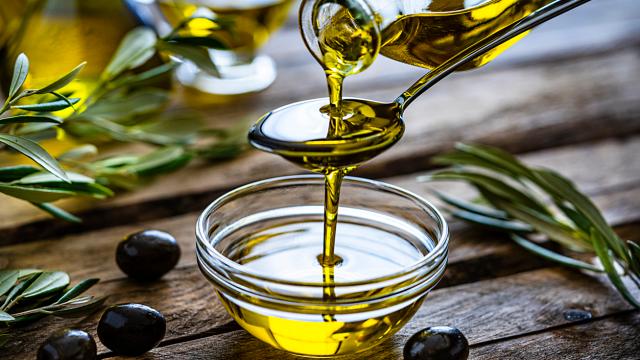Cooking without fat is doable, but not fun. Not only does fat equal flavor, it promotes browning, helps seasonings cling, and keeps food from sticking to the pan. There is an overwhelming number of cooking fats on the market, but the average kitchen doesn’t need all that many.
You need two, maybe three, cooking oils in your kitchen: Something all-purpose, but flavorful, like olive oil; something neutral that can withstand high-temperatures, like vegetable oil, and you’ll probably want some butter as well, because butter is delicious (and good for baking).
How to choose an all-purpose cooking oil
This is the stuff you’ll use to sauté vegetables, pan fry an extra crispy egg, or whip up a vinaigrette. You can even use a high-quality all-purpose oil as a “finishing oil,” and drizzle it over hummus, roasted vegetables, or a light pasta dish. For most people, this oil is olive oil. Olive oil comes in many different forms, but as we’ve discussed previously, the following three are the most common:
- “Regular” olive oil: The bottle will just say “olive oil” or “pure olive oil,” in an attempt to rise above its station. This is usually a blend of virgin and refined olive oil, which means at least some of it has been heat- and/or chemically treated. It has a pretty neutral flavor, and can used for all-purpose cooking.
- Extra virgin olive oil: “EVOO,” if you’re a food blogger from the aughts. This is the good, unrefined stuff that has the most color, flavor, and antioxidants. It has a decently high smoke point of 410℉ (210°C), which means you can to make a salad dressing, then turn around use it to sauté and deep fry—but be aware that a good extra virgin olive oil will flavor everything it touches, and it would be pretty expensive to deep fry with, given the amount of oil deep frying requires.
- “Light” oil: This oil is not lacking in calories, but in flavor and color. It is refined, and has a higher smoke point of 465°F (240°C), so feel free to use it for frying.
Another good all-purpose option is avocado oil, which has a rich, grassy flavor and even higher smoke point of 520℉ (270°C). (This makes it safe for any kind of cooking, but I still wouldn’t recommend it for deep frying, considering the price.)
How to choose a neutral oil
Vegetable oil does not have a sexy reputation, nor does its cousin, canola oil. Both have a decently high smoke point of 400℉-425℉ (200-220°C), are virtually flavorless, and contribute very little outside of fat. In some cases, that’s a good thing.
I like using vegetable oil for searing steaks (because it lets the meat speak for itself), deep frying (because it’s cheap), and even when whipping up the occasional vinaigrette (when I want to highlight a flavor that is not olive oil). If you want to taste your oil, choose something tasty, like olive oil; if you want to taste the food, and only the food, go with vegetable oil. (Or Crisco, which is essentially “vegetable lard,” and has a smoke point of 490℉ (250°C).)
Cheap butter is fine
A kitchen without butter is like an egg without salt—technically functional, but no fun at all. I like to keep two types of butter in my kitchen at most times: a cooking butter, which is cheap and salted; and a snacking butter, which is also salted, but not cheap. Cheap butter, however, is still pretty good for snacking.
The question of salted and unsalted butter is one that’s hotly disputed amongst recipe writers. As someone who almost never bakes, I am perfectly happy with the salted stuff (because salt tastes good), and on the rare occasion I do bake, salted butter has never caused a problem. If however, you are watching your sodium levels, or want to do some fancy baking, unsalted will fry, sauté, and melt just as well as the salted stuff (and it will brown even better).
Butter is safe to store at room-temperature for reasonable periods of time, provided the temperature of the room is itself reasonable. Keep one stick in a butter keeper or butter dish, and rest in the fridge or freezer, where it will last for three months and up to a year, respectfully.
Use butter for baking, sautéing, and pan-frying, but avoid high-temp cooking. Browned butter is lovely, but burnt butter is less nice. In addition to cooking, it also makes a great finishing fat; melt it into mounds of potatoes, spread it on toast, drizzle it over popcorn, or dollop it onto a steak. And, if you’re trying to avoid dairy, don’t sleep on these newfangled margarines that are often marketed as “plant butter.” The name may be annoying, but the flavor is pretty good.
Lead Image Credit: iStock

Leave a Reply
You must be logged in to post a comment.